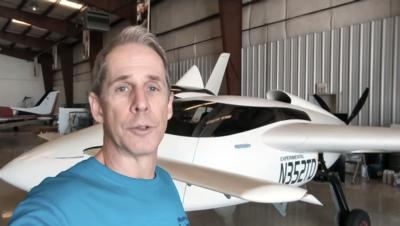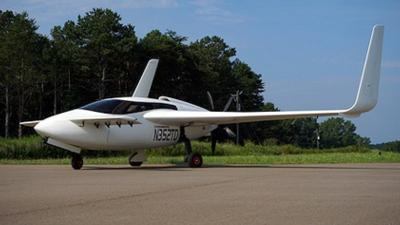Much Hyped And Over-Promised Aircraft Appears To Have A Number of Problems
Several days ago, a fair part of the experimental aircraft world was agog at the first flight of an experimental aircraft ostensibly headed for the kit market... some day.

The Raptor Aircraft 'Raptor' made bold promises... "The Raptor is an extremely spacious 5 place, pressurized, composite aircraft with a 62" wide cabin with a possible top speed of 300 knots that can cruise at 230 knots true on 7 gph of Diesel or Jet-A. It will come equipped with an optional BRS airframe parachute, constant speed propeller and anti-lock brakes. It's a luxury SUV for the sky." The Raptor is powered by a Muller-designed Audi 3.0 TDI diesel automotive conversion. He is promoting kits that are expected to cost $130,000.
It's designer, Peter Muller, financed the program off what is reported to be over 1500 $2000 deposits -- held in escrow and augmented by occasional appeals for additional financial help.
The multi-year project has been widely criticized for making what many believe to be unrealistic claims... while a number of people once associated with the project have abandoned it, or Muller. It is known to use some questionable hardware and engineering, and is currently well over 800 pounds heavier than its design weight. However; Muller soldiers on... and keeps a fan base heavily invested in his progress via dozens of highly-detailed videos that have followed the development of the program with great transparency.
It finally started making some crow hoops in late July off a shorter runway at his former home base, but experienced test pilots brought into the program, advised moving the program to an airport with a much larger runway and better emergency landing areas, as well as leaving Muller with a list of improvements they felt needed to be addressed. Ultimately; there was a parting of the ways between Muller (pictured) and the flight-test team he had once hoped would get the program airborne.

Last week, Muller grabbed a helmet, mounted up and attempted to fly the aircraft out of Valdosta Regional Airport, which has one runway measuring some 8000 feet -- and he needed a lot of it. Muller posted video of the short test flight... demonstrating that the aircraft had an abnormally long take-off roll, some visible issues with the landing gear, a very poor climb rate, serious and observable control issues in pitch as well as some lateral issues, and a powerplant system that was about to overtemp -- all this in a flight that barely lasted 3 minutes from start to finish.
To be honest, the flight was a bit terrifying to watch. Muller is not a test pilot, but managed to get the aircraft back on the ground by aborting the full pattern flight and back to a nearby opposing runway. The pitch oscillations were particularly notable (both in frequency and amplitude) and signaled that there were serious problems to be dealt with before eveni thinking of attempting another flight.

Muller has set about trying to correct issues, though observers with significant aviation credentials, are not sure that Muller is properly identifying the problems and the solutions he's intent on deploying. ANN agrees.
The project will require serious effort to complete, and we're hoping that Muller reconsiders the abandonment of the test flight team and seeks to employ a properly experienced pilot as well as getting aerodynamic and engineering advice before attempting further flight... but even with all that, and providing that the known issues can be fixed and other unknown issues do not prove to be too ponderous, we have grave doubts as to whether this project can meet its performance goals and whether the aircraft can be produced for the SportPlane kit market at the cost he promised. We applaud his transparency, and his perseverance... but this is a program that appears to need some serious outside evaluation by expert personnel.
ANN has reached out to Raptor... and received no reply.
We'll keep you apprised.
 ANN's Daily Aero-Term (04.20.24): Light Gun
ANN's Daily Aero-Term (04.20.24): Light Gun Aero-News: Quote of the Day (04.20.24)
Aero-News: Quote of the Day (04.20.24) ANN's Daily Aero-Linx (04.21.24)
ANN's Daily Aero-Linx (04.21.24) Aero-News: Quote of the Day (04.21.24)
Aero-News: Quote of the Day (04.21.24) ANN's Daily Aero-Term (04.21.24): Aircraft Conflict
ANN's Daily Aero-Term (04.21.24): Aircraft Conflict





